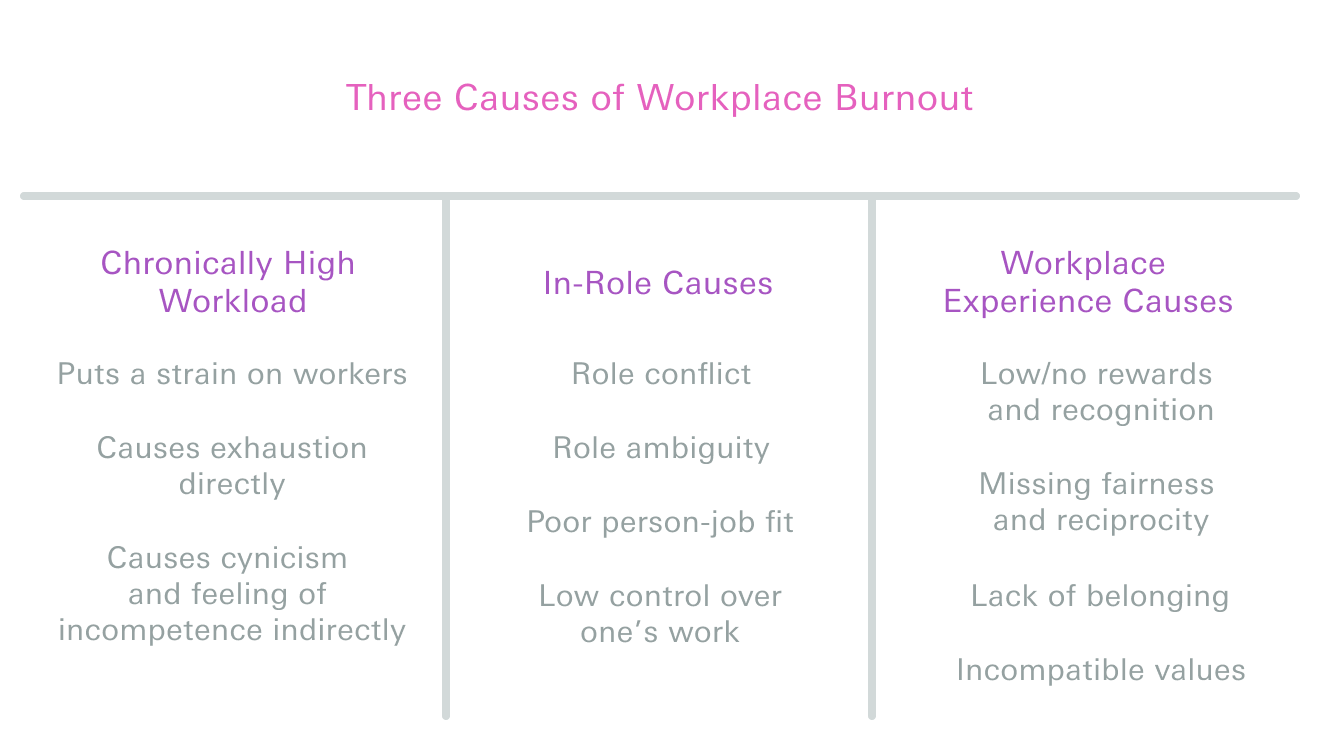Mark, an emergency room nurse, has been working 16-hour days since the COVID-19 crisis hit his city. He is mentally drained and physically exhausted. Tired of his work, Mark feels cynical about the impact he’s having. He tries to detach from the job to protect against feeling overextended. Through all this, Mark thinks he’s not a good nurse; he feels incompetent and his patient care metrics are dropping. Dissatisfied with his work, Mark wants to leave his job.
Frontline healthcare workers like Mark are experiencing burnout all around the world. But burnout hurts employees in all industries, during a crisis and without it. Burnout is just the symptom of an unsustainable work situation. To fight this insidious problem and engage workers again, we need to know three things about burnout: the causes, the effects, and the solutions.
To solve burnout, we need to know exactly what it is; there are three elements of burnout. Described in the visual below, burnout has three parts, typically in this order: exhaustion, cynicism, and feelings of incompetence.
- Exhaustion is physical, mental, and emotional, leading workers to feel overextended and depleted of all their resources.
- Cynicism can show up after exhaustion, pushing employees to distance themselves from work by being disengaged, negative, or withdrawing from the position.
- Then feelings of incompetence creep in, making workers evaluate themselves poorly and minimize their accomplishments. Now, let’s see what causes these symptoms.

What Causes Burnout?
Burnout has many causes: some impact all three elements of burnout, while others increase exhaustion directly. Overall, burnout comes from a work environment with too many energy-draining demands and not enough resources, like support and control over your life inside and away from work. A high workload, especially for a long time, leads to exhaustion which breeds cynicism and feelings of incompetence.
The remaining causes of burnout fall into two domains: your role at work and the broader workplace experience. In a work role, burnout comes from role conflict, ambiguity in the position, bad person-job fit, and low control over work. Role conflict comes from one person having many incompatible demands on their time. For example, a business analyst reporting to their division head and a project manager might have competing priorities from each boss. In the broader workplace experience, employees with low rewards and recognition, missing fairness and reciprocity, a lack of belonging, and incompatible values have more burnout. If your company has these issues, watch out for burned-out employees in your future.

What are the Effects of Burnout?
Burnout is expensive for employees, companies, and the healthcare system. The effects of employees’ exhaustion and cynicism hurt everyone along two dimensions: workplace effects and physical symptoms. In the workplace, burnout is linked to dissatisfaction with your job, less commitment to the organization, more calling in sick, higher turnover, and worse performance. These problems at work can spread to the home, where burned-out workers’ problems spill over into their marriage and their family life.
With schools closing from COVID-19 outbreaks, working parents know all about the spillover from home life to work-from-home life and the physical problems that come with it. Physical symptoms of burnout range from sleep issues to chronic diseases: people experiencing burnout report headaches, sleep problems, cold and flu symptoms, muscle tension, hypertension, and gastrointestinal issues. Fortunately, companies can avoid these symptoms of burnout by addressing the root causes directly.

How do we Prevent Burnout?
Fortunately, research on burnout in the workplace found two ways to prevent a stressful work environment from turning into physical problems and workplace disengagement. In a study of 992 employees over 12 months, researchers tracked burnout and work-life metrics to predict which employees would experience “full burnout” on all three dimensions. Employees who experienced more unfair work situations and who only felt exhaustion but not the other two burnout elements, were likely to tip over into a burnout state one year later.
This means that a fairer and more supportive workplace is less likely to create burnout in employees one year later. Unfairness can look like: unequal sharing of workload and pay, poorly handled evaluations or promotion cycles, or employee disputes where both voices aren’t heard. Employees who see their superiors as fair and supportive were less susceptible to burnout and more accepting of major changes in the organization. Designing fair practices and processes can save companies lots of money and time in labour costs. High turnover can raise businesses’ recruitment, hiring, and training costs while losing workers’ knowledge and skills that contribute to customer service and internal efficiency.
To avoid this, companies can now identify and target employees at risk of burnout with counselling, time off, training, and fairer practices. This stops employees from feeling worse over time about their workplace, sending them down a negative spiral towards quitting.
Pinpoint burnout risk early on
Orgnostic allows companies to run automatic micro-surveys to track levels of cynicism, exhaustion, and self-esteem among their employees. By combining these qualitative constructs with quantitative indicators of equity compositions, companies use our platform to find and address specific burnout risks before they balloon into a full-on crisis.